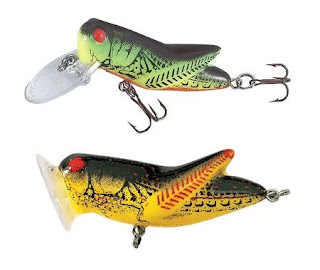There is nothing like a giant Bluegill or Redear smashing a hardbait. These fish (sometimes as tall as they are wide) will strike to stun or kill their prey as their small mouths are built for tearing, mashing and biting. In fact, most all pan fish are seemingly built from solid muscle, and can put up a fight on light tackle that should thrill any fisherman, no matter their skill level or experience. Typically, these fish make a living hunting all sorts of creepy-crawlies in the water column, swarming and attacking in ravenous packs like Piranha, with the largest of the group leading the charge – if your presentation properly matches the hatch. The best lures that I’ve found that match the hatch for these mini pugilists are the insect imitators by Rebel. I throw these baits on a thin diameter, light test super line (Spiderline), spooled onto small yet capable (see my review of the Micro Lite Elite) spinning outfit. A balanced, medium action rod with a fast tip is best here. This series of baits covers the entire water column, from topwater poppers to sinking crankbaits - so technique varies depending on model used. These small lures are ultra-realistic and detailed enough to fool any would-be predator, offering the best reproduction of prey insects available on the market today.
The Rebel Bumble Bug: Bugs twitching on the surface attract fish, and the Bumble Bug is no exception. This ultra-light lure features a wide-wobbling action. It can be fished as a topwater lure or as a crankbait. Twitch it. Crank it. Pop it. I fish this lure mostly as a topwater or wake bait. It mimics both a fallen flying insect and a frog, depending on your colour choice. Its larger profile attracts Largemouth Bass as well (top to bottom: Junebug, Horsefly, Bumble Bee, Hornet, Lady Bug).

The Rebel Crickethopper & Crickethopper Popper: The small Crickhopper resembles crickets and grasshoppers during different stages of the year and can be used as a topwater lure or as a crankbait. I have had tremendous success using a retrieve mixed with a number of pauses, allowing the bait to slowly rise to the surface. The Crickhopper Popper is the first tiny “popping” critter of its kind. This realistic ultra-light will cause a commotion on the surface, imitating a drowning grasshopper. Twitch it to make it “pop” across the water's surface (top to bottom: Firetiger, Yellow/Black).
The Rebel Big Ant & Hellgrammite: The Big Ant is an ultralight lure that features loud, fish-attracting rattles and a wide-wobbling action. It can be fished as a topwater lure or as a crankbait, but I like to get this bait ripping at a good pace, and twitching it much like a jerkbait. A good place to throw this bait is around overhanging branches, or to similar spots where ants or flightless insects my fall into the water. The darker colours can also mimic a crawdad. The Hellgrammite is a small sinking crankbait that mimics the large aquatic larvae of the dobsonfly (or "toe biter"), which are much used by fishermen as bait as bass and pan fish find them quite tasty. This bait is best dredged through areas of soft, weed-free substrate, popping off the bottom and kicking up a telltale wake of muck and debris (top to bottom: Silver Ant, Molting).
Topwater Bottom Line: Trophy pan fishing can be quite rewarding, challenging and fun to boot. These fish will bite all day long, all summer long, even in the heat of mid-day. A great way to target them is with reaction hardbaits just like the ones Rebel offers in its line of insect imitators. You can expect to pay less than 5 dollars per unit for most of these baits, so keeping a full complement is relatively inexpensive. The best part of the equation may be that these lures can work overtime, providing you with valuable Largemouth Bass fishing lure options on pressured bodies of water (a few of these insect lures also come in upsized versions as well). As always, please practice catch and release with these lures.
Topwater Rating:




No comments:
Post a Comment
Thoughts?
Note: Only a member of this blog may post a comment.